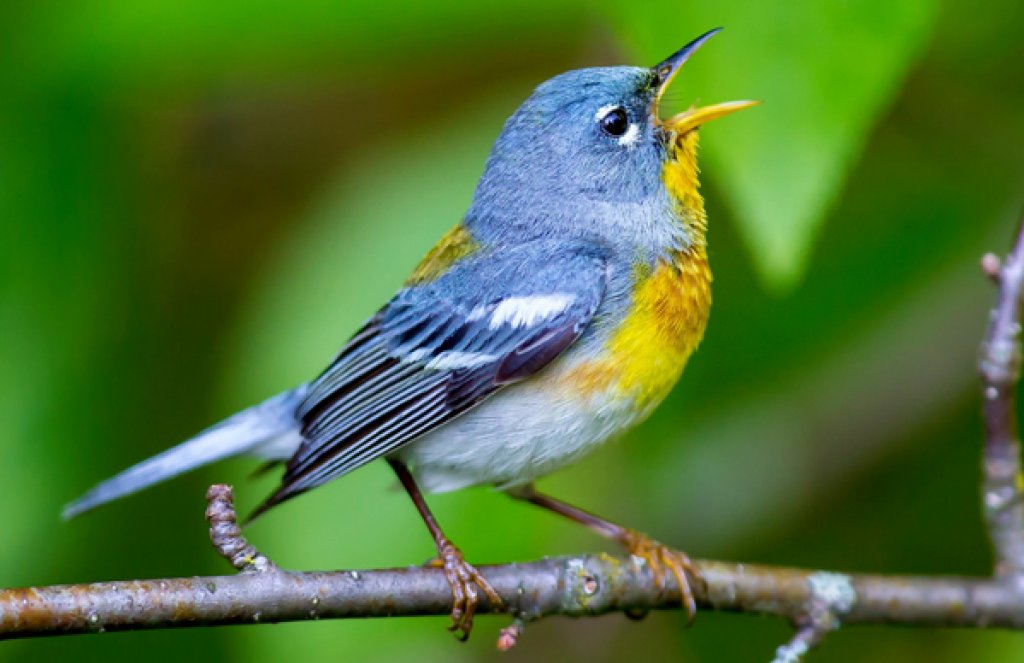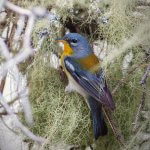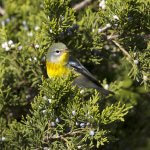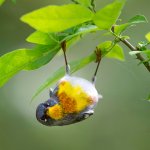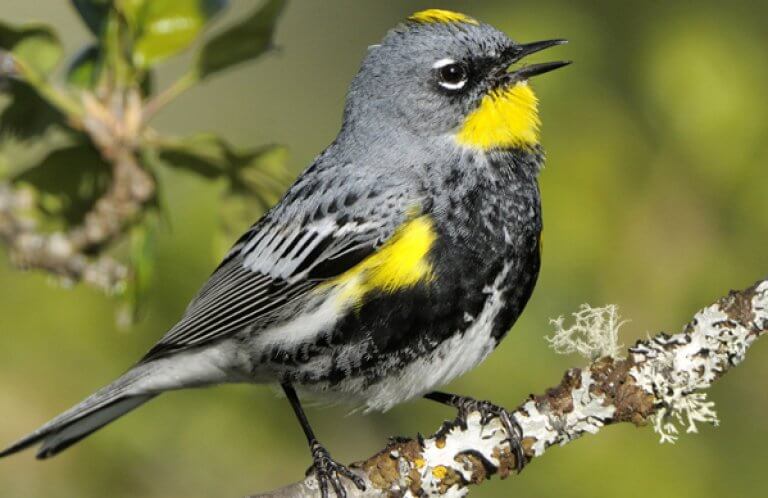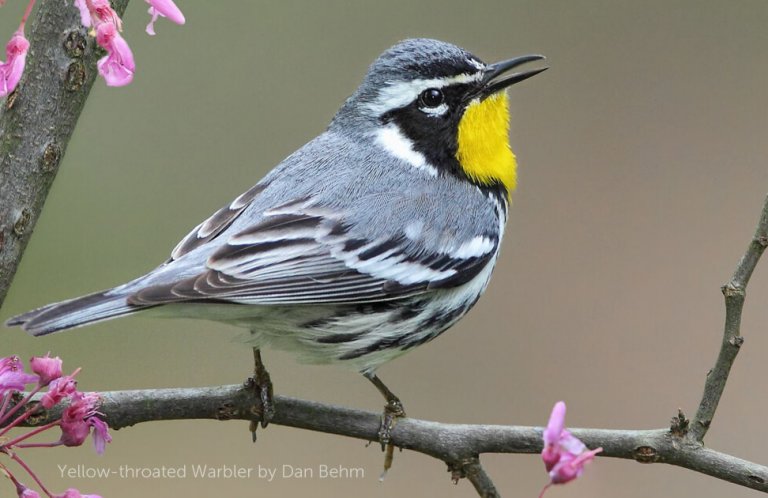About the Northern Parula
You'll hear birders say, “Look, there's a Northern ‘Pa-RU-la,' or ‘PAIR-a-la,' or ‘PAR-ya-la.'” No matter how it is pronounced, the Northern Parula is a beautiful and easily recognized wood-warbler, if you crane your neck enough to see it cruise the treetops.
Found primarily in the East from spring through fall, this 4.5-inch-long songbird has a short tail, blue-gray head, and unstreaked, bright yellow chin and breast that contrast its whitish belly and flanks. Also note its unusual bright white — but short — wingbars, and the white arcs above and below the eyes. If you see the top side of this bird, you'll see another good field mark — the olive-green back patch.
The adult male has a bold and distinctive chestnut-and-black breast band. Female parulas have coloration that is more muted, more gray than blue, and they lack the breast band. First-year birds resemble females but are more greenish on their upperparts.
Different sources say the correct pronunciation is “PAR-you-lah,”and “PAR-a-la.” Either way, the accent is on the first syllable. Parula is a diminutive form of Parus, which refers to the taxonomic family Paridae — which includes chickadees and titmice. So, Parula effectively means “little titmouse,” even though the Northern Parula is a member of the family Parulidae — the wood-warblers. (Note: Paridae versus Parulidae.)
Confused yet? Don't be. Even though all wood-warblers fall under the Parulidae family, when it comes to the common names in English, there is only one other parula, the Tropical Parula. A close relative to the Northern, it breeds well to the south of its cousin, from South Texas to central South America.
The Northern Parula wasn't always known by its somewhat puzzling name. Eighteenth-century naturalist Mark Catesby called the species “Finch Creeper” and John James Audubon and Alexander Wilson called it the "Blue Yellow-backed Warbler."
Restless Foliage Haunter
The Northern Parula is an active forager. As it pursues tiny invertebrates, it frequently works its way to the outer branches of the mid- to upper canopy of trees. During migration, parulas also forage in the understory. Watch for fluttering at the tips of branches as they nab their prey.
Northern Parulas hop quickly through branches and fly with rapid wingbeats. They tend to travel in pairs or alone on the breeding grounds, but form mixed-species flocks with other warblers during migration and on the wintering grounds.
Songs and Sounds
Moving through branches high in the canopy, Northern Parulas sing again and again and again, often alternating two song types. The most frequent is an ascending, buzzy, insect-like trill that climbs to an abrupt end.
Throughout the species' range, males sing both the rising song and one that is a bit slower and more level. Learning both of these songs is a great way to find this species.
Listen to the two song types in this clip:
Singing a (Somewhat) Different Tune
Ornithologists note an interesting regional variation in the rising song: Northern Parulas in the western part of their range sing a slightly different version of this song that ends with a somewhat lower and burry note. Research suggests that birds that primarily use the eastern version breed from central Ontario east to Maine, and south through Alabama and northern Florida. Those singing the western version breed from western Ontario south into eastern Texas.
Breeding and Feeding
The courtship and pair bonding behavior of Northern Parulas have not been well documented but males defend their nesting territories with singing and chasing. The species is considered socially monogamous — a male and female stay together through nesting season, caring for the young in their nest. However, rare cases of polygamy have been reported.
This species' preferred nesting sites are along streams or in swamps in mixed woodlands and mature forests, especially those with hanging epiphytes, such as Bearded or Lace Lichen and Spanish Moss. The nest is usually located at the end of a branch between six and 100 feet above the ground.
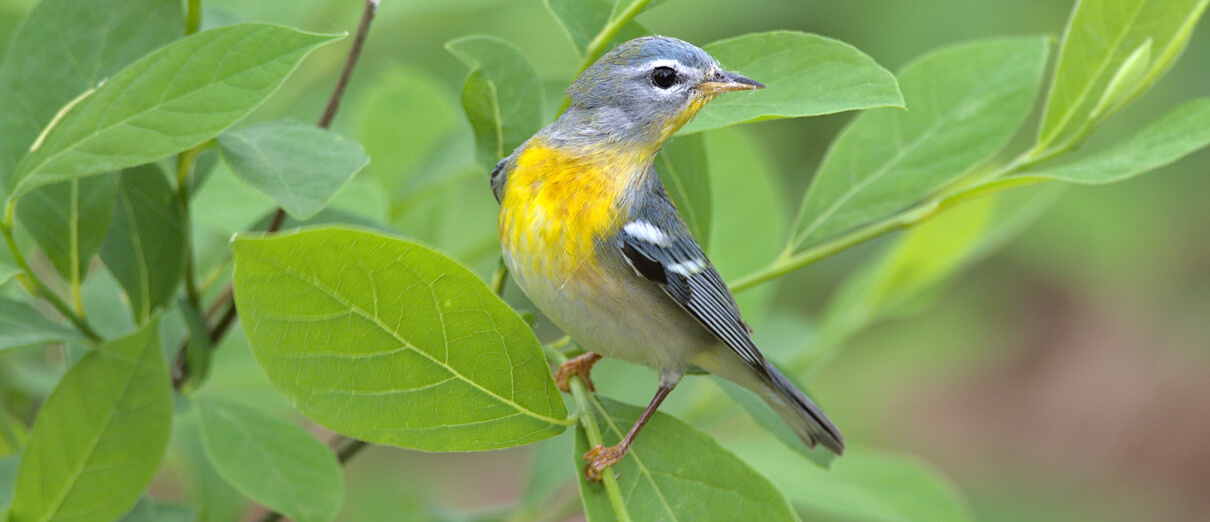
The female does most of the nest-building, which involves hollowing out a tuft of hanging vegetation to form a cup with a side entrance. When hanging epiphytes are not available, she may construct a hanging nest from other materials, or build it in debris that accumulated in branches during high-water flow in a stream or river.
The female typically lays three to five white or cream-colored eggs, specked with reddish, especially on the wide end. Only the female incubates, for about two weeks. Her mate feeds her during this time and also helps her feed the nestlings. The young leave their nest about 10 days after hatching, but they cannot fly for a few more days.
The Spineless, Beware
Northern Parulas are primarily insectivores, with a diet that includes spiders, caterpillars, and many other kinds of invertebrates, including beetles, moths, ants, wasps, bees, flies, locusts, scale insects, plant lice, lacewing flies, and mayflies. This prey is gleaned from leaves and branch tips. Sometimes parulas hawk for insects in midair. On their breeding territories they occasionally eat bud scales. On wintering grounds, Northern Parulas have been observed eating fruit, seeds, and nectar, but they still mostly opt for insects and spiders. In mixed forests, they prefer to forage in coniferous rather than deciduous trees.
Region and Range

Northern Parulas nest from the southeastern reaches of boreal forest south to Florida, but a map of the breeding range shows an odd break in the middle, roughly in the latitude of the Great Lakes through Cape Cod. They do not breed in parts of Iowa, Wisconsin, Michigan, and some states in the Northeast. The reason for this odd gap has been attributed to habitat loss and air pollution — which affects the growth of the hanging moss these birds prefer for nesting. In the north, they breed from Manitoba to the Maritime Provinces, including southern Ontario and Quebec, and south into northeastern Minnesota and Wisconsin, northern Michigan, and northern New England. This warbler's southern range stretches from the Mid-Atlantic states, west to far-eastern Nebraska, then south to Central Texas and Florida. There are rare records of this species nesting in western states, including California.
Northern Parulas winter primarily in eastern and southern Mexico, northern Central America, the Caribbean, and in peninsular Florida. There, they utilize many different kinds of cover, including forests but also tree- and shrub-dotted fields and pastures, scrub, and coffee, cacao, and citrus farms.
There are no recognized subspecies of the Northern Parula. On rare occasions, the species has been known to hybridize with Yellow-throated and Yellow-rumped Warblers.
Conservation of the Northern Parula
Epiphytes such as Bearded Lichen and Spanish Moss are highly sensitive to changes in air quality, so air pollution can, on a local or regional scale, cause habitat degradation that limits where this warbler can nest.
Northern Parulas are also frequent victims of collisions with human structures, including towers and glass.

Help support ABC's conservation mission!
Despite these threats, the Northern Parula's global population is considered stable. It has increased by 62 percent since 1970, according to Partners in Flight. But populations are declining in some regions, according to the North American Breeding Bird Survey, attributable to air pollution, deforestation, and the draining of swamps.
Get Involved
Policies enacted by the U.S. Congress and federal agencies, such as the U.S. Fish and Wildlife Service, have a huge impact on migratory birds. You can help shape these rules for the better by telling lawmakers to prioritize birds, bird habitat, and bird-friendly measures. To get started, visit ABC's Action Center.
Living a bird-friendly life can have an immediate impact on migratory birds in the United States. Doing so can be as easy as adding native plants to your garden, avoiding pesticides, and keeping cats indoors. To learn more, visit our Bird-Friendly Life page.
ABC is involved in a number of large-scale conservation initiatives to protect and recover habitat for migratory birds, including BirdScapes and Joint Ventures. ABC's Collisions program offers solutions to keep the Northern Parula and other migrants safe from collisions.
American Bird Conservancy and our Migratory Bird Joint Venture partners have improved conservation management on more than 6.4 million acres of U.S. bird habitat — an area larger than the state of Maryland — over the last ten years. That's not all: With the help of international partners, we've established a network of more than 100 areas of priority bird habitat across the Americas, helping to ensure that birds' needs are met during all stages of their lifecycles. These are monumental undertakings, requiring the support of many, and you can help by making a gift today.





































